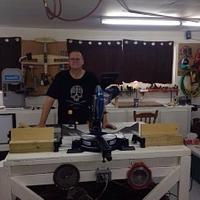
Jeff Vandenberg
in about 11 years
Woodworking Drawbore Joinery
Woodworking Drawbore Joiner (as noted workbench magazine copy right)
Workbench Magazine featured two projects that were joined using an “old fashioned” technique: drawbore joinery. They used it to join the parts of a screen door, and to join the legs and stretchers on the base of a workbench.
This is really one of my favorite joints. Now I have a biscuit joiner, and I use it. However, the editor of workbench stated… “But when I need a really strong joint — whether it’s going to take a beating, like in the base of a workbench, or be subjected to the rigors of the weather, like in an exterior door — a drawbore mortise and tenon joint can’t be beat.”
The technique for making a drawbore joint is just like making a pinned mortise and tenon joint. Start with a mortise and tenon joint. But rather than simply drilling holes and driving pegs through the joint to hold it together (which is very strong), you can create a joint that will draw itself up tighter as it’s assembled.
To do this, first dry fit the pieces to be sure they fit properly. Then disassemble the joint. Now drill the peg holes through the mortise (both sides) just as you would if you were making a regular pinned mortise and tenon joint.
After drilling the holes, reassemble the pieces and mark the location of the holes on the tenon. Then disassemble the joint to drill the holes through the tenon, BUT position the holes slightly closer to the shoulder of the tenon. This way, when you drive the pegs into the holes they will draw the tenon very tightly into the mortise.
How much should you offset the holes? It doesn’t have to be much. In hardwoods for fine furniture, 1/32" is enough. In softwoods like the pine workbench base, 1/16" is plenty. In a large timberframe structure, 1/4". Just don’t over do it. A slight offset will draw the joint up nicely.
TIP: Chamfer the leading end of the pegs to make them easier to drive in.
Jeff Vandenberg aka "Woodsconsin"
5 Replies
On the advise of my friend Bently, I used draw bore for my picnic table.
https://woodworkingweb.com/entries/135-the-top
It saved my a lot of headache during glue up.
It has been out there in the element since I finished it and holding very well.
Abbas, Castro Valley, CA
I have used this type of joint when strength is a must! It creates very tight joints that almost are impossible to separate. I used this on my “Roubo” workbench.
CHRIS, Charlottetown PEI Canada. Anytime you can repurpose, reuse, or recycle, everyone wins!
That is so awesome that you guys used this jointery. Very nice. How long has it been sitting in the elements Ianwater?
Jeff Vandenberg aka "Woodsconsin"
It’s been out since April 2014
Abbas, Castro Valley, CA
Nice.
Jeff Vandenberg aka "Woodsconsin"










